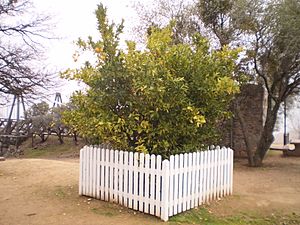Mother Orange Tree facts for kids
Quick facts for kids Mother Orange Tree |
|
|---|---|

The Mother Orange Tree
|
|
| Location | 400 Glen Drive, Oroville, California |
| Reference no. | 1043 |
The Mother Orange Tree is the oldest living orange tree in Northern California, United States. It was planted in 1854. This special tree is located in Oroville and is recognized as a California Historical Landmark.
Contents
History of the Tree
Early Life and Location
The Mother Orange Tree was first planted in 1854. Its original home was in Bidwell's Bar, close to the Bidwell Bar Bridge. This tree is a type of Mediterranean sweet orange. Its scientific name is Citrus × sinensis.
The part of the tree that grows underground, called the citrus rootstock, came from Mazatlán, Mexico. It traveled to California on a ship. In 1856, Judge Joseph Lewis bought the two-year-old orange tree in Sacramento. At that time, an orange tree was very unusual in Northern California.
Alfred Clarke and his foreman, Howard Burt, planted the tree. They placed it at the western entrance to the Bidwell Bar Bridge.
Growth and Popularity
As the years went by, the Mother Orange Tree grew very well. It reached a height of over 60 feet (18 meters). Miners loved to visit the tree. They would taste its sweet fruit. They also saved the seeds to plant in their own yards.
Each year, the tree produced a lot of oranges. On average, it yielded about 600 pounds (273 kg) of fruit. The oranges would ripen between February and May.
Moving the Mother Orange Tree
First and Second Moves
The Mother Orange Tree has been moved two times to keep it safe. The first move happened in 1862. This was done to protect it from floods from the Feather River.
The second move was in 1964. This move was necessary because of the building of the Oroville Dam. The tree was carefully moved to the California State Park Headquarters in Oroville. James Edward Huse, a crane operator, was chosen for this important task. His family had helped move the tree when it was first brought to the area.
Why the Tree is Important
The survival of the Mother Orange Tree was a big deal. It showed that citrus trees could grow well in the cooler climate of Northern California. This encouraged many people to start growing oranges around Oroville. Most of the oranges grown there now are a different type, called navel oranges.
Recent Events and Preservation
Facing a Frost
In 1998, there was a very bad frost. The cold weather caused the tree to stop growing fruit for several years. Because of the frost, a type of fungus entered the tree's trunk. This fungus caused the inside of the trunk to become hollow.
Cloning for the Future
To make sure the tree would continue to live, experts helped. In 2003, scientists at the University of California, Riverside successfully made clones of the tree. Clones are exact copies. Three of these new trees were brought to Oroville and planted.
Since then, the original Mother Orange Tree has started to produce fruit again. Near the tree, you can find a special commemorative plaque. This plaque marks the tree as a California Historical Landmark.
See also

